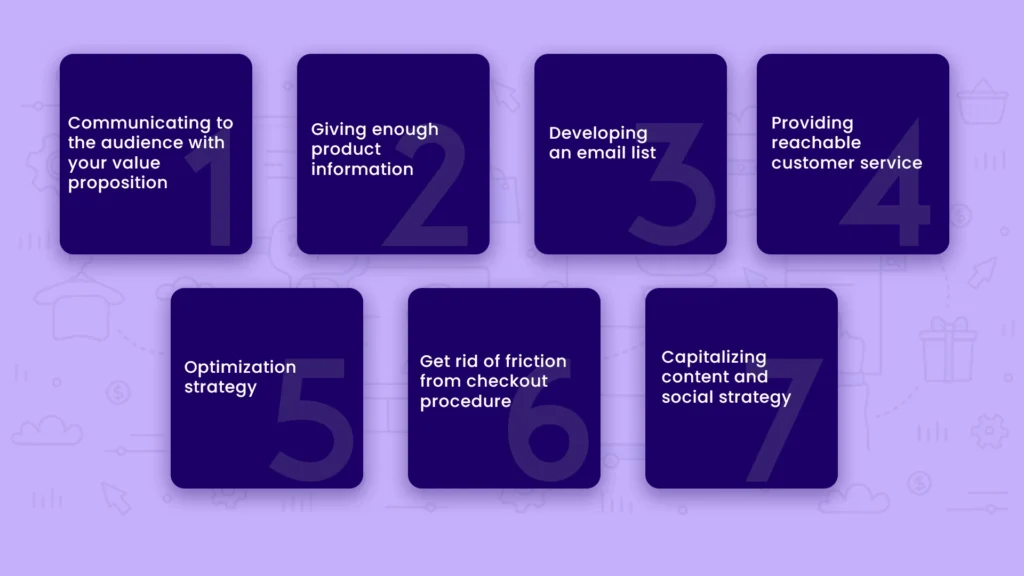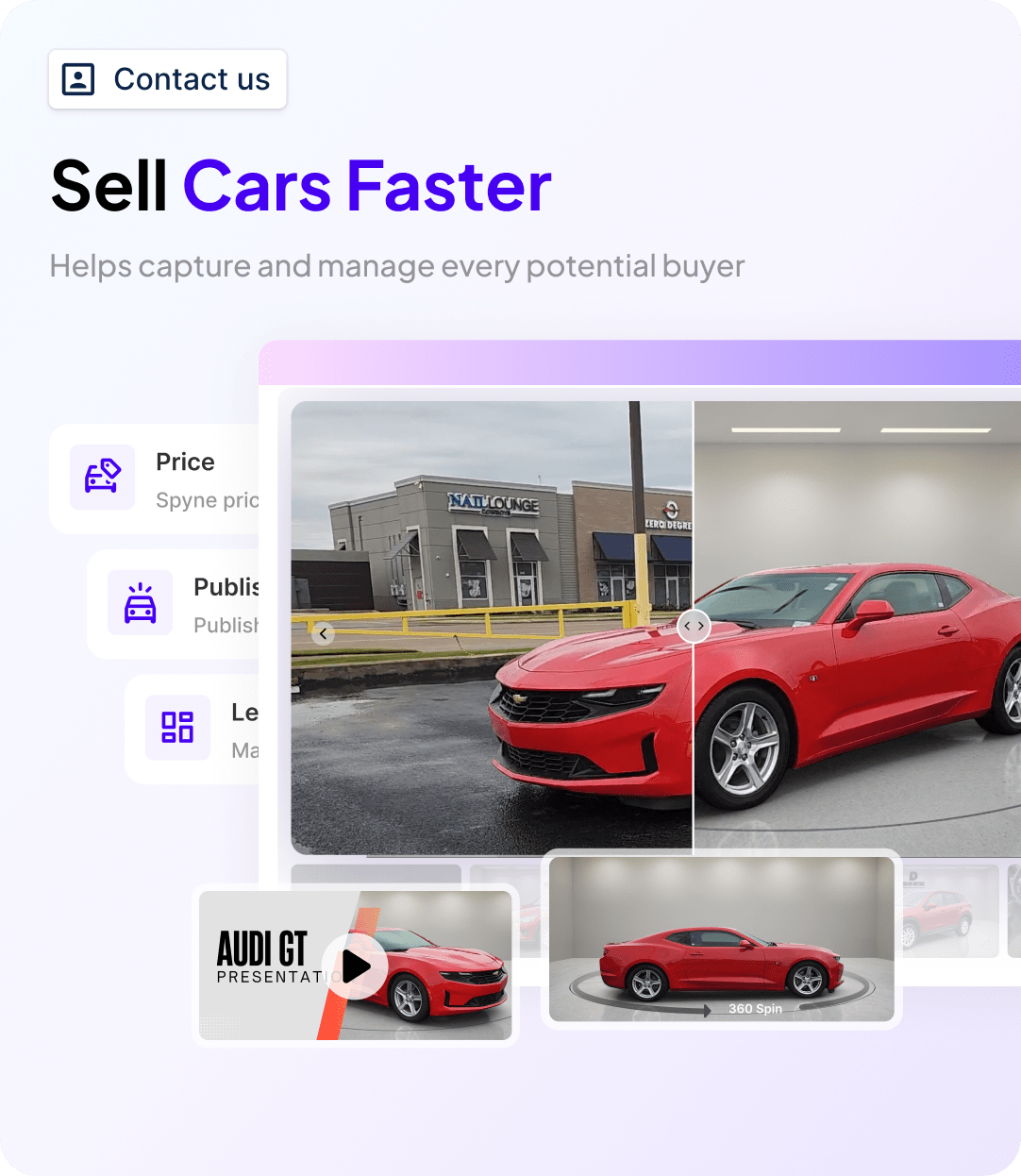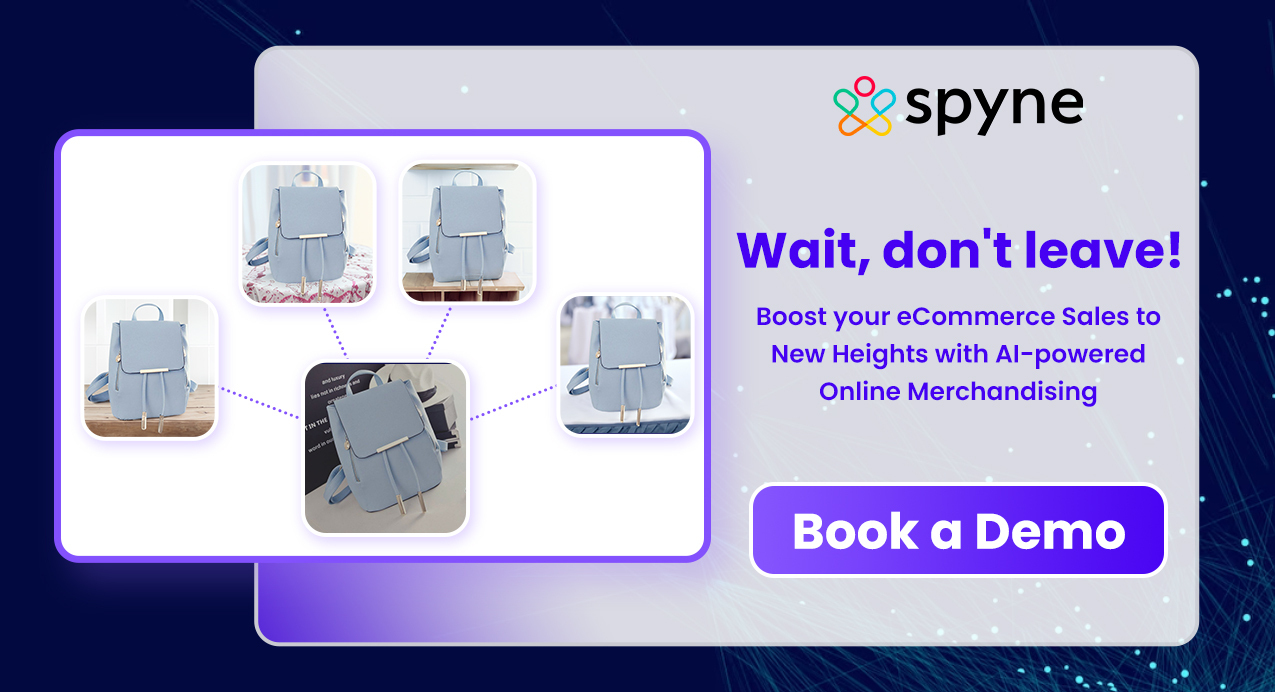In an increasingly digital world, ecommerce has become a driving force in the global economy. The numbers speak for themselves: data shows that Global ecommerce sales in 2022 were estimated to be around $5.5 trillion, according to eMarketer. This represents a growth of 16.9% from 2021. While these figures highlight online retail’s tremendous growth and potential, it’s crucial to recognize the unique challenges that ecommerce businesses face daily.
From fierce competition to changing consumer expectations, ecommerce entrepreneurs must navigate a complex landscape to succeed. The statistics reveal some of the most pressing challenges: shopping cart abandonment rates, for instance, average a staggering 69.57%, resulting in lost revenue opportunities. That’s why we’ve created this comprehensive blog dedicated to unraveling the complexities, helping you identify e-commerce challenges and solutions.
What is E-commerce?
Ecommerce also known as electronic commerce, refers to trading or exchanging of goods and services through online platforms on the internet. It is estimated that 2.14 billion people worldwide purchase goods and services online. It was also recorded that people who were using Prime were shopping online through Amazon stores; that amount surmounted to 200 million. Opportunities of ecommerce are vast; thus, ecommerce becomes an opportunity for small businesses to sell their products at a scale and reach potential customers worldwide.
What Do You Mean by the Challenges of E Commerce?
Challenges of ecommerce, including the technical and economic challenges of e commerce, refer to online businesses’ obstacles and difficulties in conducting their operations and achieving success in the digital marketplace. These issues of ecommerce can arise from various aspects of the e-commerce ecosystem, including technology, marketing, customer experience, logistics, competition, and regulatory compliance. Digital commerce encompasses many issues businesses must navigate, such as customer acquisition, retention, supply chain management, inventory control, payment processing, website optimization, cybersecurity, and staying up-to-date with evolving industry trends. One of the major ecommerce issues and challenges is converting visitors into paying customers.

E-commerce challenges can vary in complexity and impact, and businesses need to identify, understand, and address these challenges effectively to thrive in the competitive e-commerce landscape. There are many more ecommerce challenges that we will discuss later in this blog.
E-Commerce: Silver lining to the 2024 retail sector
There has been a huge change in ecommerce trends since the COVID era. There were some issues in implementing e commerce for small businesses. Still, according to data, the pandemic era led to a 50% increase in shopping. The number of online shoppers in the US market also increased by 133%. Now, up to 90% of customers expect a brand to provide a shopping experience consisting of online and in-store channels.
In today’s retail market, gaining consumer’s attention and getting them to buy from online stores is one of the major challenges of B2C e commerce. But there is an effective way to succeed in ecommerce through immersive visual content. Prominent sellers acknowledge this fact, and when conducting e-commerce, high-quality product visuals are among their most powerful assets. It is found that 90% of purchasers prefer product imagery.
Personalization is another way that ecommerce businesses can use to drive better performance and customer outcomes. Through personalization, ecommerce businesses can curate a shopping experience for their customers.
Biggest Ecommerce Challenges in 2024 & Solutions to Solve Them
There are differences in the challenges of ecommerce industry based on what type of business they are conducting and the scale of their business. We can identify the challenges for two big ecommerce companies and SMBs (Small and Medium Businesses). So, let us explore these ecommerce challenges 2024
1. Data and cyber security
One of the biggest global issues in e commerce is security breaches. The fact there is a lot of personal data and information when involved in ecommerce, and any kind of technical issue can cause serious damage to a business’s daily operations. Thus, security is one of the significant challenges of online shopping.
Solution
Be aware and active. Ensure that you have backed up your data. You can also install security plugins that you apply to your websites to prevent any kind of information stealing and hacking. Thus, this will also reduce your risk of identity theft when engaging in e-commerce.
2. Identity verification
Identifying whether the person who is visiting the shop online is the right person can be one of the ecommerce business challenges. If you don’t have the right information then how can you really proceed? Well, it can be tricky to find the right solution, but one solution is to invest in online identity verification.
Solution
There are many ways to apply online identity verification. For example, you can include biometrics, AI, one-time passwords, two-factor authentication, and many more.
3. Captivating the perfect customer
Shoppers have now too many options to choose from. If a shopper has to buy any product, they do some research and finalize it. To make sure that the right customer really wants your product, you need to have the right strategy for it.
Solution
Nowadays, digital marketing is preferred more over the traditional way of marketing because they can easily find and target your ideal customer. With the right research and analysis, your products can show up to ideal customers.
4. Customer experience
Ensuring a successful eCommerce website by delivering an exceptional customer experience (CX) or user experience (UX). Shoppers anticipate a level of expertise comparable, if not identical, to what they would encounter in a physical store.

The website’s navigation flow, structural organization, and the customization of retail offerings to align with individual shopper preferences are critical components in achieving this objective.
Solution
There are many ways to improve the user experience. A straightforward way would be to make the website plain and simple. The next step would be to have a clear call to action. Another way is to create an attractive ecommerce catalog.
5. Loyalty in customer
Acquiring new customers can cost up to 5 times more than retaining an older existing one. The success rate is also high regarding existing customers compared to new ones. These given facts are proof of how important is customer loyalty.
Solution
Here are several distinct approaches to customer retention. Firstly, providing exceptional customer service is paramount. While a customer is pleased with a great product, their satisfaction reaches new heights when the customer service is exceptional. Secondly, maintaining communication with the customer through their preferred method—whether it’s email, SMS, or blog posts—is crucial. It’s essential to identify the most effective communication channel for your specific customer.
6. Covert shoppers to paying customers
Another one of the biggest challenges of ecommerce business is to convert shoppers into paying customers. An eCommerce website may experience high traffic, numerous clicks, and impressions, yet fall short of achieving its sales targets. What strategies can they employ to boost their sales performance?
Solution
Always think from the shopper’s perspective. First and foremost, it’s crucial to grasp why your shoppers aren’t completing their conversions. Are you effectively targeting your desired audience? Is your mobile website functioning smoothly? Are technical issues a recurring problem on your online platforms? Is there a strong level of trust from your customer base? Are you implementing effective website personalization for your customers? Is your visual merchandising good enough to catch customer’s attention?
7. Competitor and competition analysis
Many people are tired of the options given in the market these days. Looking at it from a retailer’s perspective, what strategies can they employ to distinguish themselves in a crowded marketplace and attract shoppers to their website, instead of losing them to competitors offering similar products?

Solution
Always do proper research and deep analysis of the competitors. Learn to keep in touch with your customers and identify how your rivals are targeting their leads. Finally, offer services that can be unique and better than your competitors but also relevant to your customers.
8. Shipping and pricing
We’ve all come across customers who favor shopping at locations offering free shipping. eCommerce giants like Amazon have set a high standard with their enticing shipping offers, making it challenging for others to compete. How can businesses reduce their shipping expenses?
Solution
While it may not be possible for all eCommerce websites to eliminate shipping costs entirely, it’s essential to explore alternatives that align with your specific customer base. Could a subscription model potentially reduce shipping expenses? Are there specific times of the month when lower shipping costs could be offered? Alternatively, is there a dependable carrier that provides cost-effective rates? Thorough research is key to identifying the optimal solution for your shoppers.
9. Refund policies and product return
According to current data, more than 60% of online shoppers look for a return policy before they finalize their purchase. An ecommerce website with no refunds makes the customer more nervous.
Solution
For any retailer, customer satisfaction is supreme. Therefore, implementing a versatile return and refund policy not only contributes to customer contentment but also encourages customers to make purchases with confidence.
10. Selecting the right technology and partners to fix the ecommerce challenges
The selection of the right technology or partner can determine the success or setback of your business. A retailer’s expansion might be hindered by technological limitations or by engaging a bad agency to oversee its projects.
Solution
You can partner with various AI platforms or service providers that can help you take advantage of the latest trends in ecommerce marketing.
11. Customer support
There are a rising number of management issues related to e commerce. One of them is maintaining great customer support. Nowadays, customer support has been enhanced by integrating chatbots, which facilitate quicker ticket processing and response times. Nevertheless, a significant portion of customers may experience discomfort or dissatisfaction when encountering automated responses from chatbots.
Solution
The solution to this challenge in eCommerce is straightforward. ECommerce companies should employ a hybrid approach, combining technology and human assistance to address customer support needs.
12. Ecommerce across the border
Many eCommerce websites often become stagnant because they need to engage with customers beyond their geographic and linguistic boundaries. Users who do not speak the website’s primary language often seek retailers to provide a more user-friendly experience in their language. Additionally, variations in pricing, tax rates, and other factors can discourage users from making cross-border purchases.
Solution
You have to implement a multi-lingual site that is easily translated for customers according to their primary language. Employing technology to facilitate seamless currency conversion and accurate product taxation will also substantially contribute to growth.
13. Budgets
As digital marketing becomes the standard for many eCommerce enterprises, an increasing number of companies are directing their investments toward digital and social media advertising. However, as the demand for clicks and virtual advertising space rises, so do the costs.
Solution
Develop different customer profiles to improve your ability to target social media and digital advertisements effectively, therefore maximizing your return on investment.
14. Going omnichannel
Products sold through multiple channels allow you to increase your overall revenue. A customer who engages across multiple channels tends to spend up to three times more than the typical customer. Yet, if not executed correctly, certain channels may result in losses if they fail to attract the right customers or achieve the necessary volume of customer engagement.
Solution
Utilize the data gathered from various channels in your operation to pinpoint the top-performing ones and tailor them for optimal customer engagement.
15. Data privacy
Today, customers know the importance of their data and how crucial it is to keep it private. Device manufacturers such as Apple are taking additional steps to safeguard user data from third-party access.

Nevertheless, user data can empower platforms to deliver an enhanced user experience.
Solution
To overcome these ethical issues in ecommerce, gather zero-party data, wherein your customers willingly and deliberately share their information with your brand, as opposed to collecting third-party data, which is a practice that today’s customers approach with significant caution.
16. Logistics
Many companies across the world are affected due to supply chain problems. These issues occur during multiple stages which causes expenses and delays.
Solution
Attain complete visibility into your entire supply chain. Supply chain visibility allows for accurate inventory tracking and establishes a transparent communication system to keep you informed about various aspects of the supply chain process. While addressing this eCommerce challenge demands time and effort, it remains exceptionally vital.
17. Store Agility
It is important to integrate an agile company model. Remaining aware and keeping a proper understanding of trends is imperative for eCommerce enterprises to not only survive but also flourish, delivering the optimal user experience to their customers.
Solution
Make sure that your team is capable of adapting to a quickly changing market and is able to make quick decisions.
18. Customer expectations
Modern consumers are well-informed and aware of the latest advancements in technology. Therefore they have high expectations for the products and services they pay for.
Solution
To solve this issue for your e-commerce venture, a deep understanding of current web design trends is essential. A comprehensive review of ongoing trends will help you identify the necessary adaptations your business needs to implement and guide you in their implementation.
19. Element placement on the website
While it may seem unexpected, the design and positioning of critical elements like the navigation bar and tabs on your website can have a huge influence on your conversion rates and sales. This is because your user interface directly contributes to the overall customer experience on your site. Users often approach sites with challenging navigation with caution, which can impact their willingness to engage and make purchases.
Solution
Do A/B test of your website and keep it consistently optimized.
20. Sustainability
Retailers are now encouraged to promote their products and delivery services as environmentally friendly, driven by growing global sustainability awareness made by consumer demand. About 60% of consumers are willing to change their buying habits to reduce their environmental footprint.
Solution
Enhance the effectiveness of your supply chain operations and pinpoint critical areas for reducing your carbon emissions to positively impact the environment.
21. Legacy systems integration
Large businesses may have legacy systems and technologies, which can pose challenges when integrating new e-commerce platforms or implementing modern solutions. Hence, achieving seamless integration and data synchronization across different systems and departments can be complex and time-consuming.
Solution
Conduct a comprehensive assessment of existing legacy systems to identify areas that require integration or modernization. So, understand each system’s functionalities, dependencies, and limitations to develop an effective integration plan.
22. International expansion
Expanding into international markets presents unique e commerce problems for large e-commerce businesses. So, adapting to diverse regulations, cultural differences, and customer preferences requires extensive planning, market research, and localized strategies.
Solution
Conduct thorough market research to understand the international target markets’ cultural, legal, and economic nuances. So, adapt your product offerings, marketing messages, and user experience to cater to each market’s preferences and needs.
23. Scalability
As large businesses handle more transactions and customers, scalability becomes a critical challenge. Hence, ensuring the e-commerce infrastructure, systems, and processes can handle increased demand and growth without compromising performance or customer experience is essential.
Solution
Invest in a robust, scalable infrastructure for increased traffic, transactions, and data volumes. This may involve using cloud-based solutions, scalable hosting services, and load-balancing technologies to ensure optimal performance during peak periods.
What are the top e-commerce challenges for SMBs?
SMBs (Small and Medium-sized Businesses) in the e-commerce industry face unique challenges that can impact their growth and profitability. Overcoming these barriers of e commerce can be difficult.

1. Communicating to the audience with your value proposition
It’s simple to become engrossed in emphasizing your product. After all, whether you’re marketing fishing lures, vintage records, or specialized podcasting equipment, your ultimate goal is to attract consumers to buy these items. Nevertheless, there’s frequently a significant distinction in the audience within various niches. Identifying this distinction can significantly enhance your overall strategy, including your marketing efforts.
2. Giving enough product information
Purchasing a product online has become the norm. Consumers have been conditioned to browse the internet for the specific items they desire, trusting that some mysterious entity will deliver their package. However, today’s customers rely on specific information to determine whether they should buy the desired online products from you. Effective product communication revolves around three key aspects, which can be easily addressed:
Visuals: Shoppers crave visuals. Ideally, your product images should be of top-notch quality and resolution, showcasing the product from various angles.
Comprehensive Product Descriptions: Use your value proposition as a guide for your language choices. Consider whether your product description provides enough detail. Would someone be more inclined to purchase “An elegant black dress” or “An ink-black sheath dress featuring an elegant boat neck, a flattering A-line cut”
3. Developing an email list
When a visitor engages with your website and completes a transaction, an instant connection is established. Savvy businesses convert these site visitors and customers into email list subscribers, cultivating them for future sales opportunities. Ensure you have a prominent and eye-catching email sign-up form on your website. Seek permission to add customers to your email list during the checkout process. Implement an automated drip campaign that delivers valuable content tailored to your customers’ interests, whether it’s informative articles or enticing discount coupons to encourage them to return for more shopping.
4. Providing reachable customer service
Building trust is important, and nothing builds trust more effectively than being transparent with your customer service information and contact details. When you hide or make it challenging for customers (or potential customers) to reach you, it diminishes their willingness to engage with your business. Therefore, ensure your website features a dedicated contact page. Display your business name and physical address prominently on your website. Whenever possible, don’t solely rely on a contact form. Provide a customer service email address or, even better, a phone number that users can call. Explore using live chat, an increasingly popular means of connecting buyers with your customer service team.
5. Optimization strategy
Consumers often spend their time browsing your website, shopping for products, and completing the checkout process on their tablets and smartphones. Is your optimization strategy aligned with this mobile-centric reality? Do your web pages offer a visually pleasing and swift experience on small smartphone screens? Is your design user-friendly for touchscreens? Does your checkout process cater to the demands of discerning mobile users? Ensure your website is optimized to accommodate various types of mobile devices.
6. Get rid of friction from the checkout procedure
When a customer reaches the checkout process, your goal is to remove any distractions or obstacles that could hinder them from completing their purchase. Conversion specialists refer to these as ‘friction points.’ For instance, are you requesting only the necessary information to finalize the transaction, or is your checkout form being used to gather data that could be more efficiently collected through another method? Does your website offer returning customers the option to save their information for quicker ordering? Identifying and eradicating friction points during checkout is among the most critical actions you can take to boost conversion rates.
7. Capitalizing content and social strategy
In today’s fast-paced digital landscape, individuals are inclined to examine the content you create and your online presence. These platforms are crucial in attracting potential customers to your sphere and reinforcing your credibility. To create a successful strategy:
Understand your audience: Who is your target audience? What are their primary concerns and interests?
Topics: Create a catalog of subjects that pique their interest. For example, suppose you’re in the business of salad spinners. In that case, you might delve into topics such as diverse salad recipes, the advantages of various greens, or broader lifestyle subjects like encouraging finicky children to consume vegetables.
Products: Consider crafting specific content pieces about the products you offer, particularly for individuals seeking more information about these items.
Diversify your formats: E-commerce establishments frequently produce blog posts, conduct giveaways in conjunction with longer articles, and experiment with various types of social media content to ascertain which resonates best with their audience.
Conclusion
In conclusion, e-commerce presents numerous business opportunities to thrive in the digital age. There are several hurdles to overcome, from the start-up phase to the growth and expansion of large e-commerce companies. While the e-commerce landscape is ever-evolving, adaptable, innovative, and customer-centric, businesses can tame these online marketplace challenges. So, by leveraging technology, forging strategic partnerships, and staying ahead of regulatory requirements, e-commerce companies can position themselves for constant success in the dynamic world of online retail.

















